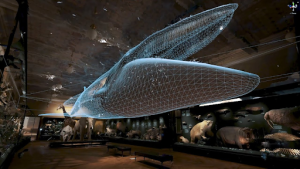
Image from MuseumNext/National Museum in Prague. Shows an Augmented Reality overlay of the Fin Whale at the National Museum in Prague.
Hyperlinked Environments: Museums and Archives
Something that caught my attention in the Hyperlinked Environments module was Virtual Reality (VR) and Augmented Reality (AR) technology, specifically as used in museum and archival spaces. Charr (2020) presented a hopeful article on museums utilizing different forms of technology to bring more people to those spaces, both physically and virtually. From a virtual tour of the Prado Museum in Madrid, to virtually experiencing an astronaut’s return from space at the Science Museum in London, Charr illuminates the endless possibilities for these technologies in museum environments. In an article discussing the seamless blend of traditional education elements and a bluetooth-enabled, smartphone-accessible AR platform at the National Museum in Prague, Richardson (2024) notes that “by embracing innovative solutions like AR, museums can not only preserve cultural heritage but also reimagine how it is shared with the world.”
The utilization of VR and AR solutions stands out as an engaging way to get those of all ages interested in visiting museums and archives. These solutions could also make museums and archives more accessible to those who may be unable to attend in person. From what I have learned in this program, a few of the goals of museums and archives are education and preservation of materials for those in the present and future to view and learn from. As the digital world continues to rapidly evolve, I think that providing more VR and AR resources would ensure that museums and archives continue to adapt to the everchanging digital landscape. In turn, a more diverse audience may be intrigued by museum and archival institutions and their holdings for many years to come.
At the present time, while Artificial Intelligence is being developed at seemingly unheard of rates, I think AR and VR tech offer more human-centric, and likely more environmentally-friendly, ways of learning and engaging with museums and archives. McGroarty (2023) notes that Virtual and Augmented Reality bring resources to the public that may only previously have been available to scholarly researchers or professionals in the fields those resources were related to. For example, some archival materials from the Chinese Historical Society of Southern California, The Huntington Library, and the Los Angeles County Metropolitan Transportation Authority are being used to build an augmented reality platform that will allow users to see Chinatown in early 20th century Los Angeles. Those involved with the project are working on reconstructing imagery of the area’s streets and buildings ca. 1850-1939, documenting information about some of the folks that lived in the area at the time, and showcasing the lived realities of people in Chinatown prior to the forceful removal of its inhabitants to make way for Union Station. This project represents the significance and power of AR technology when combined with archival material to restore silenced narratives to the greater historical record. I also think it’s just a really beautiful way to use this interactive technology to teach people about a history or event they might not have heard of before. The fact that librarians, archivists, historians, and scholars are working together on this project makes it an even more valuable representation of how we can all participate in creating new and meaningful environments designed around connecting with, and learning about, other people and their experiences.
While I don’t think we’re quite in our Ready Player One era, we’ve come a long way from the first instances of Augmented and Virtual Reality technology, and are sure to see even more innovation in the future!
A short video about the creation of the original Virtual Reality headset (Immersed Robot, 2024).
References
Charr, M. (2020, June 17). How technology is bringing museums back to life. MuseumNext. https://www.museumnext.com/article/how-technology-is-bringing-museums-back-to-life/
Immersed Robot. (2024, December 3). Ivan Sutherland and the Sword of Damocles [Video]. YouTube. https://www.youtube.com/watch?v=osH3Bmp-36k&t=9s
McGroarty, M. (2023, June 25). Virtual and augmented reality bring historical objects to life. USCDornsife. https://dornsife.usc.edu/news/stories/virtual-and-augmented-reality-bring-historical-objects-to-life/
Richardson, J. (2024, July 12). Bringing the fin whale to life: Augmented reality at the national museum in Prague. MuseumNext. https://www.museumnext.com/article/bringing-the-fin-whale-to-life-augmented-reality-at-the-national-museum-in-prague/
3 Comments
July 20, 2025 at 11:31 am
Nice reflection, Molly! The VR and AR applications are so exciting! My last non-library job was as an Administrative Assistant at a medical university. The simulation department that runs standardized patient encounters and medical procedure practice on mannequins with a variety of digital and robotic complexities now offers digital and VR experiences for practice and examinations. I had the pleasure of testing out a couple of the AR systems. The human body would show up looking a lot like the Fin Whale in your reflection. I was able to reach out and touch the simulation, move it around, look at it from all directions, including cross-sections. Menus were available to choose which structures you want to look at. Some of these simulations are complex enough to choose such features as age, gender, ethnicity, etiology, and more. It’s a real leap forward for medical education.
Thanks for sharing!
July 29, 2025 at 4:12 pm
@bsteenburg that sounds like an amazing application of this kind of technology-I love hearing about these hands-on teaching methods!! I feel like they would be so helpful for people who are more visual and experiential learners.
July 23, 2025 at 3:47 pm
@mollieg I agree – AR and VR seem a better fit for museums and archives to engage with visitors. I do think there would be a place for some type of AI powered digital presence maybe on the website for the institution. I can also see AI being used behind the scenes for many tasks that might give those that work at the museum or in the archive more time for engaging with visitors.